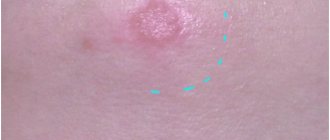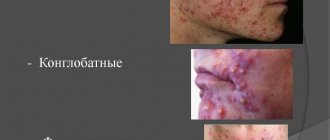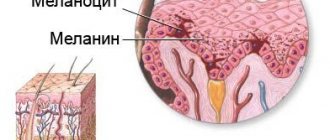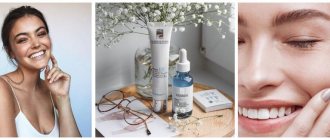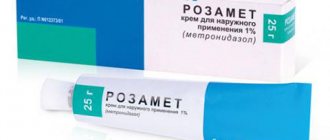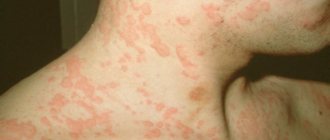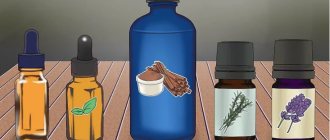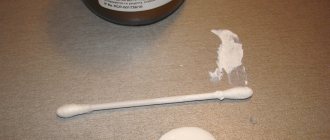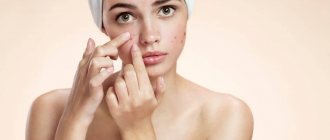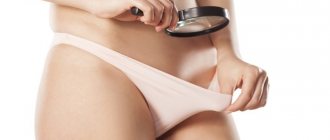Home » Skin care » Care for problem skin » Red spots from acne: how to get rid of post-acne?
One of the most common phenomena that men and women face at any age is acne on the face. Red spots, blackheads and acne are an indicator of disturbances in the functioning of the organs and systems of the body. And getting rid of rashes is not so easy. Sometimes the situation worsens due to the appearance of red spots on the skin caused by acne removal. We will talk about why rashes form on the face and how to get rid of red spots after acne in this article.
Why do acne leave spots?
There are three main reasons for the appearance of stains:
- Acne spots can appear as a result of inflammatory processes when the dark skin pigment melanin is overstimulated. It is important to remember that light pink, brownish and red acne spots are not a permanent change in the skin, but are completely reversible. If the inflammatory processes have affected the deeper layers of the skin, then very bright and dark spots after acne may remain. It’s also quite possible to get rid of them, it’s just that the healing process will take a little longer.
- The second common cause of age spots after a rash is improper treatment and errors in disinfecting acne in the initial stages of their appearance. Neglect of the inflamed rash and late visit to the doctor are also one of the reasons for the appearance of spots.
- Another, no less common reason is self-squeezing pimples. An unprofessional approach to this matter, as well as accidental infection of pimples during squeezing, subsequently leads to the appearance of various marks on the skin.
Features and causes of occurrence
Pimples and acne are often a problem during adolescence, when hormonal changes occur. But such a fate can befall even at a more mature age. The cause of rashes on the face, neck, shoulders, back, and décolleté can be different: from hormonal imbalance to problems in the gastrointestinal tract.
After long-term treatment and healing of acne, noticeable marks remain in their place. Pigment spots of this type are characterized by a reversible process. If treated correctly, they will go away quickly, leaving your skin clear and even-toned.
Why do acne spots remain? There may be more than one reason for the marks. It lies in caring for inflammation on the face, and in external factors affecting damaged areas:
- Squeezing out blackheads and pimples leads to injury to the upper layer of the epidermis. Microtraumas, when healing, are covered with a thin crust, which has a darker shade. It peels off over time, leaving behind renewed skin.
- Unprofessional acne care can lead to secondary infection. The inflammatory process is reflected in the color of the tissues, and even after it subsides, the affected area differs for some time in its tone from healthy skin.
- Illiterate use of medications can also affect the condition of the skin. Cauterization with drugs that dry the dermis leads to darkening and peeling of the upper layer of the epidermis. One of these common pharmaceutical products is a solution of high concentration salicylic acid. It does disinfect and promote healing of acne, but applying it too often and too much will cause the skin to dry out.
- The effect of ultraviolet radiation on inflamed areas can cause pigmentation. The inflammatory process is accompanied by stimulation of natural pigment. Melanin reacts to sunlight hitting the skin and makes it darker. The face must be protected with sunscreen. Some young people testify that going to the solarium helps dry out inflamed pimples. However, after 10-14 days, an exacerbation may occur.
- Lack of treatment for acne and pimples leads to post-acne. This consequence is characterized by pigment spots, scars and scars on the face. To get rid of it, they resort to hardware therapy and cosmetic procedures.
We recommend reading
- Why spots appear on the neck and how to get rid of them
- White (light) spots on the skin of the face: what is it and how to treat
- Pigment spots on the body: methods and means for eliminating them
Treatment of acne spots with medications
Such drugs include:
- creams and ointments prepared on the basis of hydroquinone with a whitening effect. It should be noted here that these products can only be used under the supervision of a doctor, since excessive use can lead to the development of skin cancer;
- alpha and beta hydroacids, the former being water-soluble, the latter being fat-soluble. They have an excellent exfoliating effect and are mechanical scrubs (glycolic, lactic, citric, salicylic acids);
- azelaic acid (it is found, for example, in a preparation such as Skinoren-gel);
- means to suppress the production of pigment, melanin (kojic acid, arbutin, magnesium ascorbyl-2-phosphate).
Medical treatments for acne spots can be used not only in monotherapy, but also in combination with each other.
Which specialist should I contact?
First you need to visit a therapist. He will determine if there are any other symptoms that have also arisen unexpectedly. For example, infection often manifests itself not only in sudden skin rashes, but also in fever.
Next, the therapist will write out a referral for examination by other specialists and determine a list of tests that should be taken.
As a rule, you need to visit an endocrinologist, gastroenterologist, surgeon and, possibly, a venereologist. Sexually transmitted infections can also cause small red dots to appear on the face or body, in particular syphilis.
After passing the tests, a diagnosis will be made and a treatment regimen will be outlined, which will help get rid of the problem.
Cosmetic treatments for acne spots
- Modern beauty salons use methods such as microcurrent therapy and fractional photothermolysis to treat acne spots. Both of these procedures are aimed at improving the condition of the skin; they accelerate the metabolic processes occurring in the skin, and also increase the rate of its regeneration. In addition, these procedures enhance blood microcirculation and increase the production of collagen and elastin (substances that even out the surface and tone of the skin).
- You can also get a chemical peel for acne spots at a beauty salon. Peeling is done on the basis of triacetic acid. Retinoids can be used to improve peeling results.
- Laser resurfacing and dermabrasion procedures are often used to remove dark spots from acne.
Why do they appear in humans?
Vascular mechanisms take part in the development of redness: through dilation of arterioles or increased permeability of their walls. But the reasons for this situation are very diverse. There are completely normal processes accompanied by redness, or pathological changes - local or systemic. And in order to determine the source of the problem for each specific case, it is necessary to undergo diagnostics.
Physiological causes of redness
A temporary change in skin color is observed when the skin is exposed to external or internal factors, after the disappearance of which the face returns to its normal appearance. This reaction is due to the activation of physiological mechanisms without causing any harm. In this case, the cause of redness may be:
- Features of the diet (eating hot and spicy foods, coffee, alcohol).
- Taking certain medications (nitroglycerin, nicotinic acid, calcium channel blockers, sildenafil).
- Excessive insolation (sunburn).
- Hormonal changes (menopause).
By and large, the skin responds with redness to any damage - friction, pressure, abrasions, insect bites, etc. In winter, the tip of the nose turns red in the cold, the skin becomes chapped, becomes dry and sensitive, and irritation occurs more easily on it. And the stronger the negative factor, the more pronounced the hyperemia will be.
Some changes are caused by a completely normal reaction of the skin to external factors - they are transient and harmless.
Red spots on a child's cheeks
The appearance of red dots on the face of children causes the greatest concern. In such cases, you usually have to think about allergies or infectious diseases with a rash. Diathesis on the cheeks is a manifestation of the child’s constitutional tendency to certain reactions. The anomaly has a clear allergic nature and can subsequently transform into atopy. Typical signs of diathesis include:
- Milk eschar, redness and peeling of the skin of the cheeks.
- Gneiss - fatty scales on the head.
- Maculopapular or maculopapular rash on the limbs and trunk.
- Strophulus - itchy nodules with serous contents.
- Persistent diaper rash in skin folds.
Children suffer from colds more often, they experience excess weight gain and anemia. The course of diathesis is wave-like, exacerbations are often associated with dietary errors, but can occur under the influence of weather factors, helminthic infestations, and dysbacteriosis.
The second most common cause of red spots on a child's face is infection. A skin rash (exanthema) is the manifestation of many childhood diseases that are viral or bacterial in nature. These include the following:
- Measles.
- Rubella.
- Scarlet fever.
- Chicken pox.
- Sudden exanthema.
Most childhood infections are characterized by the appearance of fever and intoxication with weakness, malaise, loss of appetite, catarrhal syndrome in the form of a runny nose, sore throat, pain and redness in the throat, and enlarged lymph nodes. Based on the nature of the rash and accompanying symptoms, it is possible to fairly accurately predict the diagnosis.
Dotted elements may appear on the face of a child suffering from whooping cough. They are caused by rupture of capillaries due to increased pressure in them against the background of a strong cough during a spasmodic period. In addition, in childhood there are cases of capillarotoxicosis due to influenza, mononucleosis, meningococcal infection and other diseases.
When dots appear on the face in children, one should first of all exclude infectious pathology with the risk of dangerous complications.
Small blood spots on the face of an adult
Damage to capillaries and release of blood cells into the surface layers of the skin is the main mechanism of hemorrhagic rash. Small red dots called petechiae can occur due to the following reasons:
- Vitamin deficiencies (ascorbic acid, rutin, phylloquinone).
- Vasculitis (allergic, autoimmune, hemorrhagic).
- Connective tissue pathology (systemic lupus erythematosus, scleroderma).
- Infectious diseases (typhoid and typhoid fever, enterovirus infection, hemorrhagic fevers).
When a rash appears in adults and children, it is necessary to pay attention to the likelihood of hematological pathology (throbocytopenia, leukemia) and the effects of medications. Hemorrhagic points do not disappear with pressure; they disappear gradually as vascular permeability normalizes. In this case, a color change is observed from red to brown, green and yellow.
Redness at the tip of the nose: what is it?
Quite often you can see redness at the tip of the nose. This area is susceptible to mechanical injuries (bruises, abrasions), insect bites, and inflammatory processes. These are the conditions you should think about when a red spot appears and it hurts. Purulent-inflammatory processes, which are accompanied by clear local signs, deserve special attention:
- Severe hyperemia.
- Swelling.
- Soreness.
- Increasing temperature.
As the pathology develops, pus accumulates in the center of the swelling, which shines through the thin covering of the epithelium. After it leaves, the wound is cleaned and heals. If the breakthrough of pus is delayed, then general symptoms increase (fever, headaches, intoxication), there is a risk of infection entering the skull with the flow of venous blood with the development of meningitis, abscesses, and thrombosis of the cavernous sinus.
Among the causes of red spots on the face may be acute inflammatory processes, which are dangerous due to their complications.
Small pimples near the bridge of the nose
Pimples near the bridge of the nose can be a common manifestation of acne. It is in this zone that increased secretion production by the sebaceous glands is observed, pores expand and become clogged. Acne begins with comedones, then an inflammatory reaction occurs, which is caused by propionobacteria that multiply in the mouth.
Acne looks like papules (bumps), pustules (pustules) or deep nodules. Microabscesses may form in the center of some of them. With multiple lesions, the skin takes on a bumpy appearance, and after the inflammatory elements resolve, it becomes covered with pigment spots and scars. Acne can occur not only on the face, affecting the skin of the back, chest, and sometimes the abdomen and limbs.
In addition to regular acne, rosacea can cause redness. Rosacea usually occurs in women with pathologies of the digestive system and irrational use of hormonal creams. Against the background of congestive erythema with telangiectasia, nodules and pustules that tend to merge appear.
Pimples on the nose and forehead often occur with demodicosis, a parasitic disease caused by the Demodex mite. In addition to severe acne on the skin, eye damage is considered a typical sign of pathology:
- Redness of the eyelids.
- Itching, dryness and fatigue.
- Scales at the base of the eyelashes.
- Frequent styes.
With a long course of demodicosis, growth of nasal tissue with its disfigurement is observed - rhinophyma. Damage to the scalp is accompanied by dandruff and baldness.
Removing acne spots using traditional medicine
For uncomplicated acne spots, you can use folk, home remedies. To do this, you can use the following recipes:
- Anti-acne mask based on green clay. To prepare the mask you will need 1 tbsp. spoon of green clay powder, drop 4 drops of rosemary oil into it and dilute with cool water until creamy. Keep the mask on your face for no more than 15 minutes.
- White clay and cinnamon mask. A teaspoon of clay is mixed with the same amount of cinnamon and water until creamy. Keep on the affected areas of the skin for 20 minutes and rinse with water.
- White clay and lemon mask. A good whitening effect is achieved by combining white clay (1 tablespoon) and freshly squeezed lemon juice (2 teaspoons). After rubbing the mixture until creamy, apply to the affected areas for 10 minutes.
- Essential oils. Essential oils of lavender, neroli, frankincense, take three drops of each and mix. Apply strictly to acne spots, since exceeding the required dose can cause skin irritation.
- Mask for acne spots made from protein and lemon. This mask is prepared from the white of one egg and two teaspoons of freshly squeezed lemon juice, which must be mixed and applied to spots, and washed off 15 minutes after application.
- Paraffin. Melted medical paraffin should be applied pointwise to the stains and removed after hardening. After paraffin, it is recommended to use a nourishing cream.
- Apple vinegar. By mixing apple cider vinegar with water in a ratio of 1:3, you can wipe the stains every morning.
- Badyaga. Badyaga for acne spots is actively used in home cosmetology. You can prepare a badyaga tincture yourself, or you can use the pharmacy Badyaga Forte gel, which is designed specifically for stagnant age spots after acne. It can be applied as a mask at least once a week.
- Cleansing mask made from aspirin and honey. Soak two aspirin tablets with water and grind, add a teaspoon of honey. Apply to the skin of the face, avoiding the area around the eyes, using massage movements (like a scrub). Leave for 10 minutes and rinse with warm water.
Cosmetology procedures
Often, the treatment regimen includes not only various medications, but also methods that would be more correctly called aesthetic. A cosmetologist can eliminate red spots on the face and body, for example, using cryotherapy or special procedures. Such methods to help get rid of small spots are very effective, and you should not be afraid to use them if necessary. Numerous photos prove their effectiveness. The cryotherapy procedure, used to get rid of small spots on the face, is quick and painless.
You can also try to apply several simple methods yourself, but, of course, it is better to first consult with a specialist. The effectiveness of these methods is confirmed by both reviews and photos.
First, try wiping your face with a regular ice cube in the morning, this will help strengthen the blood vessels, and thus reduce the number of red dots, and ultimately help get rid of them. Secondly, make herbal compresses. For example, you can use chamomile for this. Soak a cotton cloth in the broth and place it on your face, remove the compress after a quarter of an hour. Make sure that the temperature of the decoction is not too high: the compress should be warm, not scalding.
Specialized purchased anti-stain masks
The Tiande brand is especially popular. This is a product of natural origin, which contains medicinal plants. The mask helps narrow pores and reduces the secretory function of the sebaceous glands. Initially, it is recommended to use it every day, and then reduce the frequency of use to 2 times a week. By the way, in reviews, women often talk about the high effectiveness of Tiande products.
General principles of application
The face mask for acne spots can only be applied to skin that is free of dirt and cosmetics. Insufficient cleansing of the face and, accordingly, incorrect action of the mask can cause harm. It is important to carefully monitor the condition of the face and not to start the development of acne, pimples and pustular formations, because these phenomena are not only unpleasant in appearance and leave marks, but can also lead to infection of the entire body.
As a rule, if you treat rashes correctly and do not squeeze them out, then there will be no traces of them. Also, the problem area heals without consequences in case of infection - measles, chickenpox. When the disease passes, the skin regains its healthy appearance. Similarly, spots heal on their own after allergic rashes and redness, when the allergen has already been eliminated. In general, the need to use a face mask and the difficulty of getting rid of acne spots depends on the depth of the damage to the epidermis layer.
Contraindications
In some cases, when treated with natural remedies, redness, burning and deterioration of the skin condition may occur. Therefore, you should exercise caution and first consult with a specialist in the following situations:
- for thin and overly sensitive skin;
- if you are allergic to any components in the face mask after acne;
- if you are prone to an allergic reaction to food or natural external irritants (pollen, etc.);
- when using antibiotics;
- during an infectious disease.
Some ingredients are more irritating to the skin and are more likely to cause allergies. These include: garlic, honey, essential oils. It is important to use them carefully, testing the body's reaction on small areas of the skin.
Regular facial cleansing and choosing the right care products will help keep your skin healthy and beautiful. If rashes appear, it is important to treat them promptly and competently. If the problem area has not been completely restored, you should seek the help of special face masks for acne marks.
Author: Daria Lelyuk, especially for Dermatologiya.pro
Quickly at home
You can get rid of red patches quickly at home using salt and baking soda. To do this, you need to mix them in equal proportions and apply to the rash using a disk soaked in a camphor solution. After a few minutes, rinse off and apply baby cream.
Cleansing
The red spots that remain after acne indicate some kind of damage. In order for the skin to quickly acquire a uniform color and the area to heal, it is necessary to clean it, eliminating dead cells. To do this, you need to use facial scrubs.
It is very important that they have a gentle effect, only then can damage to existing wounds be avoided.
It is best to make a scrub at home using the following ingredients:
- 100 g corn flour;
- 50 g wheat flour;
- 100 g milk.
The components must be mixed and applied to clean, damp skin, gently massaging. Leave on the face for up to 5 minutes, then rinse with warm water.
Masks based on pharmaceutical products to even out complexion and get rid of blemishes
The pharmacy also sells a lot of interesting products that, to one degree or another, help get rid of spots on the skin. Take paraffin, for example. It is believed that it helps get rid of many skin imperfections. The product is sold in any pharmacy. All you need to do is melt it in a water bath, apply it to your face, wait for it to harden, and carefully remove the resulting film from the skin.
Many pharmacists advise using pure zinc paste in the fight against acne marks. You need to lubricate problem areas with it several times a day. As reviews show, a positive result from this application will be very soon.
Features of treatment
Even before we begin to consider methods that allow you to remove acne spots from your face, you should pay attention to the rules that must be followed by everyone who is faced with a similar problem:
- If you find pimples on your face, do not try to squeeze them out yourself;
- If you decide to use an acne cream, clean your skin before applying;
- The most suitable time for treating acne is the summer-autumn period. The fact is that when using most medications for spots, the effect of drying and thinning of the skin is observed , and in winter and spring it does not receive the required amount of nutrition;
- When self-medicating, make sure that the damaged areas do not come into contact with ultraviolet radiation;
- to obtain the best results, it is recommended to combine the main treatment with taking medications that contain vitamin C, which has a positive effect on the vitamin balance of the skin;
- Make sure your diet is balanced. Thanks to this, you will get better sooner.
How to properly use masks for acne spots?
The principles of using homemade masks for dark spots depend on what is included in their composition. For example, there are products that can be left on for a long time to achieve the best effect. Others need to be kept for a strictly set time so as not to harm the dermis. It is important to make masks regularly, only in this case you can notice the desired result after a while. But not all formulations can be used too often (for example, every day). In short, a particular mask should be used exactly as described in the recipe.
Not all acne blemish masks are suitable for dry, oily, or combination skin types. That is, when choosing a composition, you should pay attention to the components. For example, if a mask contains a lot of oils, then it is not recommended for oily skin, as well as a recipe with citric acid for dry skin.
Before using any formulation, it is recommended to prepare it in a small volume to conduct an allergy test. A small amount is usually applied to the elbow. It can be used as a mask only if there has been no reaction in the form of redness, burning, or rash.
Masks that need to be applied to the entire face should not come into contact with the area around the eyes and lips. You should also monitor the reaction of the skin while the composition is left on the face. If the slightest unpleasant effects appear, it is better to wash it off and not use it again. After applying the mask on your face for acne spots, you need to apply a moisturizer.
